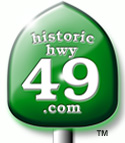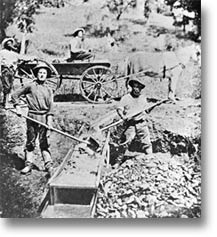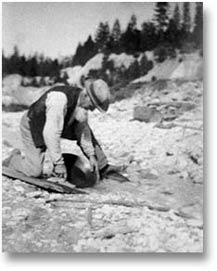                

|
DID YOU KNOW?
| The Gold Rush expended 125 million troy ounces of gold, worth more than $50 billion by today's standards.
More than 80% of the gold in the Mother Lode is still in the ground.
In 1854 the largest gold nugget ever found was in California at Carson Hill above the Stanislaus River. It weighed 195 pounds and was valued at $43,534 in the currency of the day.
In the flood of 1862 all traces of Sutter's Mill were obliterated . Not until another flood in 1924 exposed its undeveloped foundations was it "discovered." The mill was re-created using old photographs and Marshall's own drawings.
In 1869 the name "Mother Lode" was coined and referred to only five counties: Mariposa, Tuolumne, Calaveras, Amador and El Dorado. Actually more gold was later found in Placer, Nevada, Sierra and Plumas counties. |
Between 1848 and 1852, four short years, California's population grew from 14,000 to 223,000.
Top 12 gold producing counties
in California.
Each listed produced more than
$100,000,000 in gold from 1848-1965.
Nevada
Amador
Tuolumne
Butte
Calaveras
Sierra
Yuba
Sacramento
Placer
El Dorado
Plumas
Siskiyou |
$440,000,000
$200,000,000
$190,000,000
$150,000,000
$150,000,000
$150,000,000
$145,000,000
$135,000,000
$120,000,000
$110,000,000
$105,000,000
$100,000,000
|
Source: The California Division of Mines and Geology. |
GOLD MINING


|
Gold is most commonly found and or mined in one of two kinds of deposits; Placer and Lode. Placer deposits are areas of free gold that have settled in pockets after being disturbed and moved by many years weather facilitated erosion. Lode is gold found in viens buried deep underground in quartz deposits. Placer gold is mined using panning, sluicing, or dredging. Lode is mined using conventional "deep shaft" hardrock.
Placer Mining
Panning: See Below for detail directions. Using a pan in the stream to separate gold from other minerals and materials.
Sluicing: Long wood boxes are built to run water laden with gravel over a series of sieves and riffles to separate the gold from the other minerals and materials. Other variations common in the miners camps were the "Long Tom" and "Rocking the Cradle.
Dredging: Placer miners can be seen today on Gold Country rivers using gas-powered dredges to vacuum sand and gravels from pockets on the river bottom. Gold is then separated in a modern verson of the "Sluice Box".
Hydraulic Mining: Outlawed since 1884, Hydraulic Mining though extremly productive was very destructive. Entire hillsides were washed away with highly pressurized water sending tons of mud down into the rivers below.
Lode Mining
Hardrock Mining: Nevada County's most profitable and longest lasting method of mining. Gold bearing quartz is mined in vertical or inclined shafts deep beneath the earth's surface.
Troy Weight
| 24 Grain = |
1 Pennyweight
or 1.55 Gram |
| 20 Pennyweight = |
1 Ounce
or 31.10 Gram |
| 12 Ounce = |
1 Pound
or 373.24 Gram |
| Pure Gold (AU) = |
24 Karat
or 1000 Fine |
|
GOLD PANNING
|

|

Recreational gold panning can be exciting as well as laborious. Needing only a gold pan, shovel and a whole lot of patience, it is an activity that can be enjoyed by all ages.
More than 80% of the gold in the Mother Lode is still yet to be found, this makes gold panning even more enticing! Gold is found in areas where lode deposits and erosion have occurred. The best places to look for nuggets are streams, rivers, ravines, lake areas and dry ravines. If you are over- taken with Gold Fever you will be happy to know Gold Country has many waterways with numerous places for recreational gold panning.
The American River, Bear River, Yuba River, Deer Creek, Wolf Creek, Bridgeport, Colfax, Foresthill, Oxbow Reservoir, Yankee Jim's, on the Foresthill Divide, Washington (20 miles NE of Nevda City), Golden Quartz Picnic Area and Kelecher Picnic Area, just to name quite a few popular sites for prospecting. Some locations are private claims, mines or restricted use areas: please read signs carefully. |
HOW TO PAN FOR GOLD
| You will need a gold pan, a 12 or 15 inch steel pan is preferred.
Darken the pan by placing it over a burner or in a campfire. This will make the flakes of gold more noticible.
• Look for gravel bars in the middle of
• rivers or streams
• Look for gravel bars around heavy
• water runoff
• On the downstream side of large boulders
• or tree roots in streams
• In cracks above the water-line, along the
• edge of the stream
• In streaks of gravel that settle above
• streambeds and follow the
• bottom of stream channels |
Place your pan under water, keeping the pan under water at all times, filling the pan nearly full. Throw away the large stones and break up lumps of mud and clay.
Hold the pan level with both hands and rotate the pan with swirling motions. As you rotate the pan the heavier gold loosens from the sand, gravel and settles to the bottom. Tilt the pan downward to let the dirty water, sand and gravel wash over the edge of the pan.
Continue to raise and lower the lip of the pan so the water will flow over it and remove more of the lighter material.
Continue this process until nothing but gold and heavier minerals are left in the pan Carefully inspect the black sand for nuggets or tiny specks of gold or other precious minerals. |

For Current Precious Metal Prices Click Logo Above
MORE INFORMATION FOR SERIOUS MINERS
Contact the Bureau of Land Management, 63 Natomas Street, Folsom, CA 95630
916-985-4474
|
Home | Hwy 49 Map | Cities Directory | Business Directory | Bed & Breakfast | Golf Courses | Wineries | Historic Churches
Gold Rush
History | Historic
Photo Gallery | Gold
Facts | We
The People | Ghosts | General
Store | Old
Sac | Tahoe | Yosemite
historichwy49.com
Since
1999
© 2000,
2001, 2002, 2003, & 2004 historichwy49.com
e-mail: info@historichwy49.com
|






